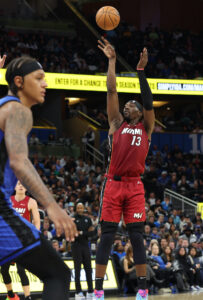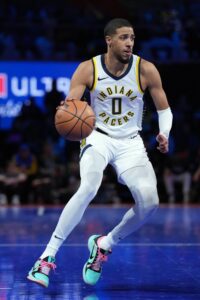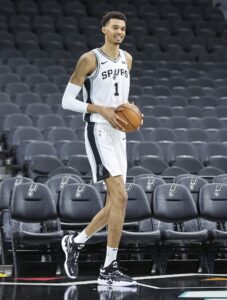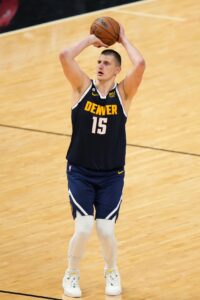As we detailed back in September, there are several players around the NBA who would benefit financially from making an All-NBA team or winning a Most Valuable Player of Defensive Player of the Year award in 2023/24.
 Heat big man Bam Adebayo, Kings guard De’Aaron Fox, Pelicans forward Brandon Ingram, Nuggets guard Jamal Murray are among the players who would become eligible to sign a super-max (Designated Veteran) contract during the 2024 offseason by earning one of those honors this season.
Heat big man Bam Adebayo, Kings guard De’Aaron Fox, Pelicans forward Brandon Ingram, Nuggets guard Jamal Murray are among the players who would become eligible to sign a super-max (Designated Veteran) contract during the 2024 offseason by earning one of those honors this season.
Mavericks guard Luka Doncic and Thunder guard Shai Gilgeous-Alexander could ensure they become eligible to sign a super-max extension in 2025 by making this year’s All-NBA team. Grizzlies big man Jaren Jackson Jr. could do the same by winning a second consecutive Defensive Player of the Year award.
Additionally, Timberwolves guard Anthony Edwards, Pacers guard Tyrese Haliburton, and Hornets guard LaMelo Ball signed maximum-salary rookie scale extensions that will be worth 30% of next season’s salary cap (instead of 25%) if they make an All-NBA team this spring. These “Rose Rule” contracts are essentially “mini” super-max deals.
Not all of those 10 players look like legitimate All-NBA, MVP, or DPOY candidates this season, but many of them will be in the mix. However, as Tim Bontemps and Bobby Marks write at ESPN.com, the newly implemented 65-game minimum requirement for award winners looms large for this group.
Without appearing in 65 games (including at least 63 of 20-plus minutes and two of 15-plus minutes), these players will be ineligible to earn an All-NBA spot, and without that end-of-season honor, they won’t be in position to receive a higher maximum salary.
According to Bontemps and Marks, a player who misses more than 17 of his team’s games, falling short of appearing in the required 65, can technically still qualify for award recognition, but only in very specific scenarios:
- If the player appeared in at least 62 games (and 85% of his team’s games to that point) and then suffers a season-ending injury.
- If the player files a grievance and presents “clear and convincing evidence” that his team limited his games or his minutes with the intention of depriving him of award eligibility.
While there’s also a clause for “extraordinary circumstances,” the NBA and NBPA don’t expect that clause to apply to injury absences, since it would essentially defeat the purpose of the rule, per ESPN’s duo.
Of the 10 players mentioned above, one is already ineligible for a major end-of-season award — Ball has appeared in just 19 of the Hornets’ first 39 games due to an ankle injury, so even if he doesn’t miss a game for the rest of the season, he’ll max out at 62 appearances. Given Charlotte’s spot in the standings, Ball would have been an All-NBA long shot anyway, but he has been playing at a very high level when he’s been healthy.
The 65-game mark remains within reach for the rest of this group, though some players can’t really afford any sort of extended absence. Adebayo, for instance, has missed 10 of Miami’s 42 games so far and only logged 12 minutes in an 11th, which means it won’t count toward his 65. Seven more missed games would cost him his award eligibility.
Murray is in a similar spot — he has missed 14 of Denver’s 43 games and played just 10 minutes in a 15th, so three more missed games would make him ineligible for award consideration.
Doncic has missed seven games for the Mavericks, while Fox has missed six for the Kings, so they’re on pace to play in enough games, but if either player turns an ankle or tweaks a hamstring and is forced to the sidelines for a couple weeks, he’d be in trouble.
It looked like that might happen with Haliburton, who sat out just three of the Pacers’ first 36 games, then strained his hamstring earlier this month. He was expected to be unavailable for at least a couple weeks, but returned to action on Friday night, ahead of schedule, after missing just five contests.
 Haliburton is a legitimate All-NBA candidate and would be in line for a projected $41MM pay increase across his five-year extension if he earns one of those 15 spots. Were those financial considerations a factor in his early return to action? Would he still have been inactive on Friday if that 65-game minimum weren’t in play?
Haliburton is a legitimate All-NBA candidate and would be in line for a projected $41MM pay increase across his five-year extension if he earns one of those 15 spots. Were those financial considerations a factor in his early return to action? Would he still have been inactive on Friday if that 65-game minimum weren’t in play?
It’s hard to imagine the Pacers allowing their franchise player to risk potential re-injury by coming back too early, but Haliburton certainly has a ton of motivation to play in every game he can this year.
As Howard Beck of The Ringer writes, that 65-game minimum will be a fascinating subplot to follow in the second half of the season. Although we’ve focused here on players whose future earnings could be directly tied to whether or not they claim an end-of-season award, there are many other potential All-NBA candidates who may fall short of 65 games, changing the equation for voters.
Joel Embiid, Jimmy Butler, Kyrie Irving, Donovan Mitchell, Devin Booker, Zion Williamson, and Lauri Markkanen are among the stars who have been out for eight or more games so far this season, Beck observes. Kevin Durant has missed seven.
The 65-game minimum isn’t necessary to earn votes for Sixth Man of the Year, Rookie of the Year, or an All-Rookie spot, but the other major awards require at least 65 appearances.
In 2023, five of the 15 players who made an All-NBA team appeared in fewer than 65 games, but that won’t be the case in 2024. The players who have the most riding on All-NBA honors from a financial perspective may be the ones most motivated to stay on the court, but as Adebayo points out, you “can’t stop injuries from happening.”
“God forbid nobody gets hurt, but you can’t [prevent] injury,” he said, per Bontemps and Marks. “I think it’s crazy that we even have the rule. It’s one of those things where you just accept the rule. … I guess use your 17 games as wisely as possible.”
 Heat big man
Heat big man  Haliburton is a legitimate All-NBA candidate and would be in line for a
Haliburton is a legitimate All-NBA candidate and would be in line for a  In every NBA league year, rookie scale amounts are assigned to each first-round slot, from No. 1 through No. 30. Teams can sign their first-rounders to as little as 80% of that rookie scale amount, or up to 120% of that figure.
In every NBA league year, rookie scale amounts are assigned to each first-round slot, from No. 1 through No. 30. Teams can sign their first-rounders to as little as 80% of that rookie scale amount, or up to 120% of that figure. Listed below are the maximum-salary contracts for players signing contracts that start in 2023/24.
Listed below are the maximum-salary contracts for players signing contracts that start in 2023/24.